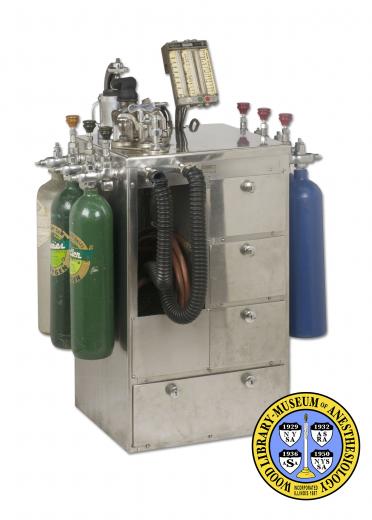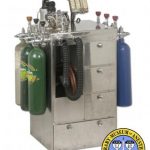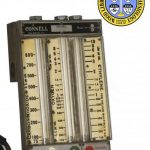Connell 1936 Model
Dr. Karl Connell (1878-1941) introduced a line of closed circuit, multiple-gas anesthesia machines in the 1930s. These were among the first to have a built-in carbon dioxide absorber. This series of machines also had ball-bearing gauges, called flow meters, to accurately display the rate of gases flowing to the patient. Incorporating the suggestions of several leading anesthesiologists of that era, the machine's safety features included glass domes to make the action of the valves controlling the flow of air and gas visible, and conducting wires inside the rubber breathing tubes to reduce the possibility of explosion. These machines also introduced solid stainless steel cabinetry. This model could deliver carbon dioxide, oxygen, ethylene, nitrous oxide and cyclopropane. Ether and helium could also be added.
Catalog Record: Connell 1936 Model
Access Key: aiwi
Accession No.: 2010-10-05-2
Title: Connell model 1936.
Author: Connell, Karl Albert, 1878-1941.
Corporate Author: Connell.
Title variation: Alt Title
Title: Connell anesthetic apparatus : table model 1936.
Title variation: Alt Title
Title: Connell deluxe cabinet model.
Publisher: Big Indian, NY. : Connell, 1936.
Physical Descript 1 anesthesia machine : stainless steel, other metals, rubber, glass ; 99 x 72 x 48 cm
Subject: Anesthesia Machines.
Subject: Anesthesia, Inhalation.
Note Type: General
Notes: Title based on manufacturer markings on machine; Alternate titles are from a
manual for the 1936 model and from the WLM name for the object.
Note Type: With
Notes: Accompanied by the original ether reservoir, which is not currently attached
to the machine, and drop chamber, fittings, and a black rubber mask.
Note Type: Physical Description
Notes: One cabinet anesthesia machine with a stainless steel exterior; This
description is based on the perspective of a user facing the front of the
machine, i.e. “left” is the user’s left, “right” is the user’s right; Three
small drawers run down the right side of the cabinet; On the left side of the
cabinet is an open alcove where the reservoir bag hangs; At the bottom of the
cabinet, a wide drawer runs under the alcove and the smaller drawers on the
right; The wheels have been removed for purposes of exhibit; The size of the
body of the cabinet, measured without the extensions, such as the yokes, is
approx. 74 x 43.5 x 40.5 cm; There are three yokes on each side of the
cabinet; From front to back on the left side of the cabinet are two yokes
with green knobs and one yoke with an orange knob; On the right are three
yokes with red knobs; A small rectangular plate is attached to the front of
the cabinet at the top and is marked with, “Made by [new line] CONNELL [new
line] New York [new line] PATENTED July 3, 1934 [new line] Other Pat’s
Pending”; To the left of this plate is an inspiratory outlet and an an
expiratory inlet; A second plate is attached to the cabinet’s top on the left
side, and is marked with, “ETHER [ether is underlined] To operate drop first
open vent-cock above the reservoir gauge 2 turns [new paragraph] INDUCTION
[induction is underlined] Begin slowly and increase drop rate as tolerated to
4 drops per second for 2 or 3 minutes [new paragraph] FULL MAINTENANCE [full
maintenance is underlined] Decrease rate gradually to one drop per second by
10th minute and to exceedingly slow drop thro the second half hour [new
paragraph] Keep reservoir vent closed when not in use and drain completely
once a month per drain cock along side bag neck; Also on the left side of the
cabinet top are, from front to back, a calibrated spill valve, three glass
domes that seal and cover flutter valves, a shunt valve, and soda-lime
canister (Based on the resemblance, the CO2 absorber on this model was
sometimes referred to as the ‘coffee mug’); A board of flow meters is on the
right side of the counter top in back, elevated approx. 7 cm above the
cabinet ; Manufacturer markings at the top of the flowmeter board include,
“CONNELL [new line] BIG INDIAN, N.Y. [new line] MODEL [new line] 1936 [new
line] 5 [three or four spaces] 21; To the right of these markings is a small
diagram that indicates how to read the flowmeters; The meter to the left is
labeled “CARBON DIOXIDE C.C. per min.”, with increments marked from 75, then
100, 200, up to 800; The meter in the center is marked, “C.C. per min.
[space] OXYGEN [space] Liter per min.”; The cc per minute area of the meter
is marked from 150, 200, 300, up to 900, and then the liter per min. area is
marked 1, 1.2, 1.4, 1.6, 2, 3, up to 8; Below the oxygen flowmeter is a green
circle with “O2” marked in white in the center; The meter on the right side
swivels, or turns, so that “Liter per min. [space] ETHYLENE [space] FOR
HELIUM MULTIPLY X 26” is visible on one side, and markings for N2O and
cyclopropane are visible on the other side; This meter is fragile and the
cotter pin is loose, so it is easy for the panel to get out of alignment;
Below the ‘Ethylene/N2O/Cyclo’ flowmeter is a red circle with “Anesthetic
Gas” marked to the right of it.
Note Type: Reproduction
Notes: Photographed by Mr. William Lyle on Sept. 23, 2010; In order to present an
image of the apparatus in the best state possible, this example was
photographed with black, ribbed, breathing circuit tubing from the Parts
Collection.
Note Type: Historical
Notes: Karl Connell, M.D. (1878–1941) developed a variety of anesthesia equipment,
including the Anesthetometer, the Connell War SP Model, and at least three
types of flowmeters. The manual for the 1936 Connell model describes its use
for a broad range of techniques: “The general plan is engineered to meet the
requirements of economy, safety and precision in a mechanism very simple of
operation. The apparatus is calibrated for all useful gases and is adaptable
to gas therapy and to all methods of general anesthesia, such as
intratracheal, constant flow or pharyngeal insufflation under low or high
pressure, constant-flow or semi-closed method, or carbon dioxide absorption
method with to & fro breathing. However, it is designed especially for the
closed-circuit carbon-dioxide absorption method. It is highly efficient for
cyclopropane anesthesia and helium therapy.” The manual goes on to explain
that many features of the machine where suggestions of practicing
anesthesiologists, “Dr. Lincoln F. Sise, Dr. Phillip D. Woodbridge, Dr. Urban
H. Eversole and Dr. Meyer Saklad,” and that prototypes “were tested by the
Department of Anesthesia of the Lahey Clinic for several years before
entering production.”



